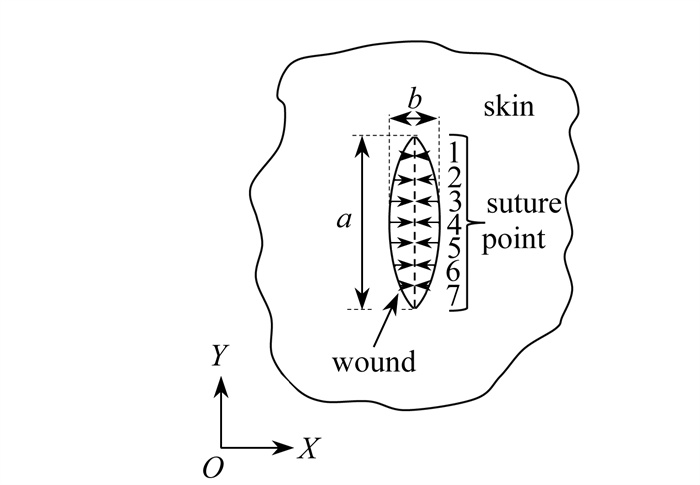A Prediction Model for Skin Wound Suture Forces With Uncertain Material Parameters
-
摘要: 为快速、有效地评估缝合皮肤伤口所需的力,运用非线性有限元方法,对不同尺寸、不同材料参数皮肤伤口进行缝合力数值计算;以计算结果为样本,采用椭球基神经网络模型,构建了皮肤伤口缝合力预测模型;考虑到皮肤材料参数的不确定性会影响数值计算结果的可靠性,预测模型采用Monte-Carlo方法进行了皮肤材料参数的不确定性传播分析;最后,以猪皮为实验材料进行伤口缝合力预测分析与测量实验,验证了该方法的可靠性.结果表明,间断缝合椭圆形皮肤伤口,缝合点处所需缝合力按缝合针次呈先增后减趋势,峰值力发生在伤口中线前,40 mm×10 mm伤口,缝合力峰值约为1.7 N;40 mm×14 mm伤口,缝合力峰值约为2.5 N.受材料参数不确定性影响,缝合力预测结果最高有±0.6 N的波动.构建预测模型的理论方法,为皮肤等生物软组织材料参数不确定性传播问题提供了有效的解决思路,同时为机器人手术缝合提供重要的力学参考信息.Abstract: To evaluate the forces required for the suture of skin wounds quickly and effectively, the nonlinear finite element method was used to calculate the suture forces for skin wounds with different sizes and material parameters. With the calculated results as samples, the prediction model for skin wound suture forces was constructed by means of the EBF neural network model. Given the uncertain skin material parameters influencing the reliability of numerical results, the Monte-Carlo method was used to analyze the uncertainty propagation of skin material parameters. Finally, the prediction analysis and measuring experiment of wound suture forces were carried out with pig skin specimens to verify the reliability of the method. The results showed that, the suture force increases first and then decreases according to the suture point sequence, and the peak force occurs before the center of the wound. For a 40 mm×10 mm wound, the peak suture force is about 1.7 N, and that for a 40 mm×14 mm wound is about 2.5 N. Influenced by the uncertainty of material parameters, the prediction results of suture forces fluctuate by as much as ±0.6 N. The proposed theoretical prediction model provides an effective solution to the problem of parameter uncertainty propagation for biological soft tissue materials such as skins, and makes an important mechanical reference for robotic surgical suture.
-
表 1 人体皮肤材料参数取值范围
Table 1. Parameter value ranges of human skin materials
parameter C10/kPa k1/kPa k2 σX/kPa σY/kPa value range 2.387~100.7 0.38~24 530 0.133~5 984.2 0~50 0~50 -
[1] 付宜利, 潘博. 微创外科手术机器人技术研究进展[J]. 哈尔滨工业大学学报, 2019, 51(1): 1-15. https://www.cnki.com.cn/Article/CJFDTOTAL-HEBX201901001.htmFU Yili, PAN Bo. Research progress of surgical robot for minimally invasive surgery[J]. Journal of Harbin Institute of Technology, 2019, 51(1): 1-15. (in Chinese) https://www.cnki.com.cn/Article/CJFDTOTAL-HEBX201901001.htm [2] REILEY C E, AKINBIYI T, BURSCHKA D, et al. Effects of visual force feedback on robot-assisted surgical task performance[J]. Journal of Thoracic and Cardiovascular Surgery, 2008, 135(1): 196-201. doi: 10.1016/j.jtcvs.2007.08.043 [3] JUNG W J, KWAK K S, LIM S C. Vision-based suture tensile force estimation in robotic surgery[J]. Sensors, 2020, 21(1): 110. doi: 10.3390/s21010110 [4] PISSARENKO A, MEYERS M A. The materials science of skin: analysis, characterization, and modeling[J]. Progress in Materials Science, 2020, 110: 100634. doi: 10.1016/j.pmatsci.2019.100634 [5] CAPEK L, JACQUET E, DZAN L, et al. The analysis of forces needed for the suturing of elliptical skin wounds[J]. Medical & Biological Engineering & Computing, 2012, 50(2): 193-198. [6] 龚博, 林骥, 王彦中, 等. 细胞骨架与细胞外基质的力学建模与分析[J]. 应用数学和力学, 2021, 42(10): 1024-1044. doi: 10.21656/1000-0887.420302GONG Bo, LIN Ji, WANG Yanzhong, et al. Mechanical modeling and analyses of cytoskeleton and extracellular matrix[J]. Applied Mathematics and Mechanics, 2021, 42(10): 1024-1044. (in Chinese) doi: 10.21656/1000-0887.420302 [7] 周磊, 王世斌, 李林安, 等. 皮肤力学的研究进展[J]. 实验力学, 2020, 35(6): 955-969. https://www.cnki.com.cn/Article/CJFDTOTAL-SYLX202006001.htmZHOU Lei, WANG Shibin, LI Linan, et al. Advances in skin mechanics[J]. Journal of Experimental Mechanics, 2020, 35(6): 955-969. (in Chinese) https://www.cnki.com.cn/Article/CJFDTOTAL-SYLX202006001.htm [8] HOLZAPFEL G A, GASSER T C, OGDEN R W. A new constitutive framework for arterial wall mechanics and a comparative study of material models[J]. Journal of Elasticity & the Physical Science of Solids, 2000, 61(1/3): 1-48. [9] GASSER T C, OGDEN R W, HOLZAPFEL G A. Hyperelastic modelling of arterial layers with distributed collagen fibre orientations[J]. Journal of the Royal Society Interface, 2006, 3(6): 15-35. doi: 10.1098/rsif.2005.0073 [10] TONGE T K, VOO L M, NGUYEN T D. Full-field bulge test for planar anisotropic tissues, part Ⅱ: a thin shell method for determining material parameters and comparison of two distributed fiber modeling approaches[J]. Acta Biomaterialia, 2012, 9(4): 5926-5942. [11] PINAR A. Recent progress of uncertainty quantification in small-scale materials science[J]. Progress in Materials Science, 2020, 117: 100723. [12] 陈鑫, 王刚, 叶正寅, 等. CFD不确定度量化方法研究综述[J]. 空气动力学学报, 2021, 39(4): 1-13. https://www.cnki.com.cn/Article/CJFDTOTAL-KQDX202104001.htmCHEN Xin, WANG Gang, YE Zhengyin, et al. A review of uncertainty quantification methods for computational fluid dynamics[J]. Acta Aerodynamica Sinica, 2021, 39(4): 1-13. (in Chinese) https://www.cnki.com.cn/Article/CJFDTOTAL-KQDX202104001.htm [13] FISHMAN G. Monte Carlo: Concepts, Algorithms and Applications[M]. New York: Springer, 1996. [14] 毛凤山, 陈昌富, 朱世民. 代理模型方法及其在岩土工程中的应用综述[J]. 地基处理, 2020, 31(4): 295-306. https://www.cnki.com.cn/Article/CJFDTOTAL-DJCL202004008.htmMAO Fengshan, CHEN Changfu, ZHU Shimin. Surrogate model method and its application in geotechnical engineering[J]. Journal of Ground Improvement, 2020, 31(4): 295-306. (in Chinese) https://www.cnki.com.cn/Article/CJFDTOTAL-DJCL202004008.htm [15] 陈浩, 林震, 刘成诚, 等. 基于直接模拟蒙特卡洛方法的真空羽流不确定量化研究[J]. 推进技术, 2020, 41(1): 73-84. https://www.cnki.com.cn/Article/CJFDTOTAL-TJJS202001008.htmCHEN Hao, LIN Zhen, LIU Chengcheng, et al. Uncertainty quantification of vacuum plume simulations using direct simulation Monte Carlo method[J]. Journal of Propulsion Technology, 2020, 41(1): 73-84. (in Chinese) https://www.cnki.com.cn/Article/CJFDTOTAL-TJJS202001008.htm [16] 李久辉, 卢文喜, 常振波, 等. 考虑参数不确定性的地下水污染源识别[J]. 中国环境科学, 2021, 41(4): 1711-1722. https://www.cnki.com.cn/Article/CJFDTOTAL-ZGHJ202104029.htmLI Jiuhui, LU Wenxi, CHANG Zhenbo, et al. Identification of groundwater contamination sources considering parameter uncertainty[J]. China Environmental Science, 2021, 41(4): 1711-1722. (in Chinese) https://www.cnki.com.cn/Article/CJFDTOTAL-ZGHJ202104029.htm [17] 赵翔, 茹东恒, 王鹏, 等. 基于NARX神经网络方法的汽轮机转子关键部位应力预测[J]. 应用数学和力学, 2021, 42(8): 771-784. doi: 10.21656/1000-0887.410372ZHAO Xiang, RU Dongheng, WANG Peng, et al. On the stress prediction of key components in steam turbine rotors based on the NARX neural network[J]. Applied Mathematics and Mechanics, 2021, 42(8): 771-784. (in Chinese) doi: 10.21656/1000-0887.410372 [18] 周杰, 赵婷婷, 陈青青, 等基于GoogLeNet的混凝土细观模型应力-应变曲线预测[J]. 应用数学和力学, 2022, 43(3): 290-299. doi: 10.21656/1000-0887.420136ZHOU Jie, ZHAO Tingting, CHEN Qingqing, et al. Prediction of concrete meso-model stress-strain curves based on GoogLeNet[J]. Applied Mathematics and Mechanics, 2022, 43(3): 290-299. (in Chinese) doi: 10.21656/1000-0887.420136 [19] BENITEZ, J M, MONTANS, F J. The mechanical behavior of skin: structures and models for the finite element analysis[J]. Computers & Structures, 2017, 190: 75-107. [20] ANNAIDH A N, BRUYERE K, DESTRADE M. Automated estimation of collagen fibre dispersion in the dermis and its contribution to the anisotropic behaviour of skin[J]. Annals of Biomedical Engineering, 2012, 40(8): 1666-1678. [21] SULLIVAN T P, EAGLSTEIN W H, DAVIS S C, et al. The pig as model for human wound healing[J]. Wound Repair and Regeneration, 2001, 9(2): 66-76. [22] 王楠, 罗岚, 刘勇, 等. 金属构件残余应力测量技术进展[J]. 仪器仪表学报, 2017, 38(10): 2508-2517. https://www.cnki.com.cn/Article/CJFDTOTAL-YQXB201710020.htmWANG Nan, LUO Lan, LIU Yong, et al. Research progress on stress measurement technology for metal components[J]. Chinese Journal of Scientific Instrument, 2017, 38(10): 2508-2517. (in Chinese) https://www.cnki.com.cn/Article/CJFDTOTAL-YQXB201710020.htm -





 下载:
下载:












 渝公网安备50010802005915号
渝公网安备50010802005915号